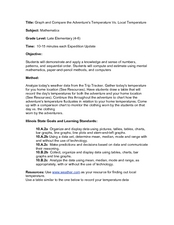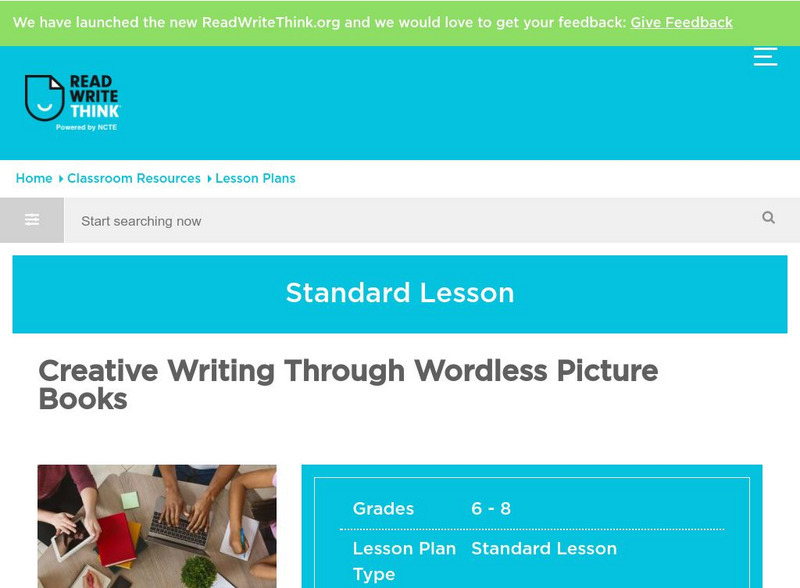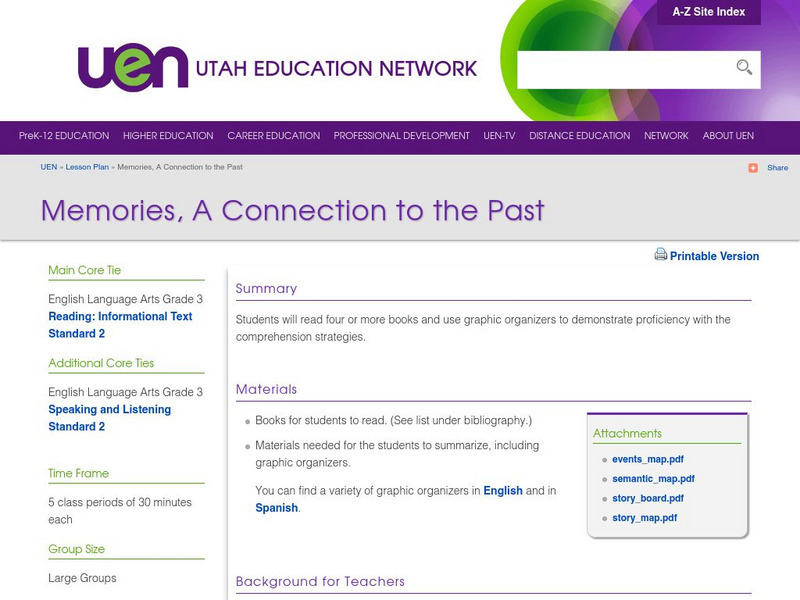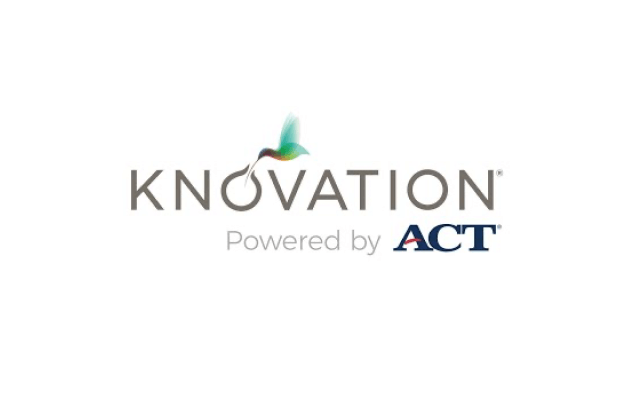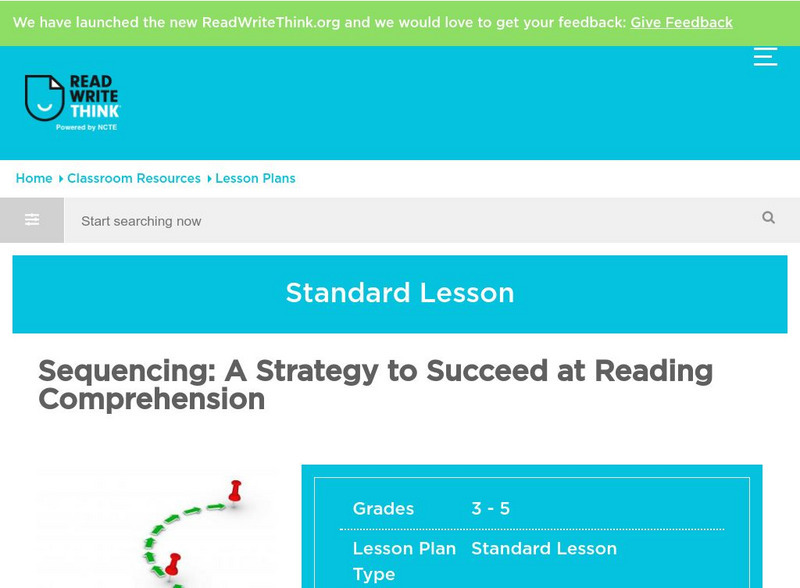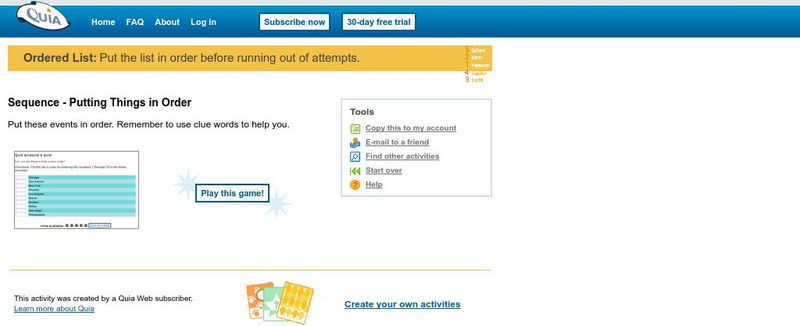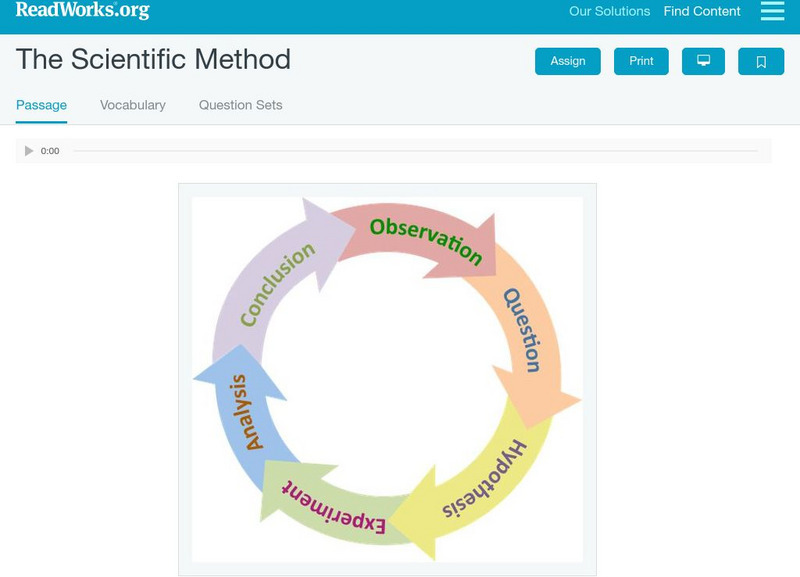Curated OER
What Comes After?
For this counting worksheet, students are given a numeral and then they write the counting number that comes next. Students use the numerals one through ten for their answers. There are ten problems on this worksheet.
Curated OER
Tell a Tale
Learners create a class story using picture cards. Each student picks a card, tapes it to the board, and retells the story in sequential order using the words then and next.
Curated OER
Reading Quilt/Main Idea
Sixth graders study main events in a story. In this reading comprehension lesson, 6th graders illustrate each event on a piece of paper with a quotation from the book and a summary of the event to represent the caption of...
Curated OER
Sequential Order
Students review vocabulary from the story they are reading. Students receive 10 sentence strips that depict the story. Students then need to place the sentence strips in sequential order and discuss with their other classmates. Students...
Curated OER
Graph and Compare the Adventure's Temperature Vs. Local Temperature
Students explore the concept graphing data. In this graphing data lesson, students use weather data from their local weather and some other city and graph them. Students plot the local weather vs. another city. Students record...
Curated OER
Sequential Writing
In this writing instructions worksheet, students use sequential order to write instructions for brushing their teeth. Students write what to do first, next, then, and finally.
Curated OER
Retelling the Main Event in Sequence
Students practice retelling the main ideas of a story in sequential order. In this story retelling lesson, students listen attentively to a story. They learn a song as they listen that helps them review the main ideas of the story as...
Curated OER
What Comes First?
In this number order activity, students fill in the missing number in ten, two-number sequences.
Curated OER
Decimals, Meters, Centimeters: Worksheet 7
In this meters worksheet, 6th graders compare units of measure written in centimeters and meters. For the kinesthetic learner, students may cut out the twelve numbers. Students match centimeter units to an equivalent meter unit. There...
Curated OER
Investigating Patterns 2
Fifth graders investigate patterns and determine what symbol or number comes next. Using a given website, they play the "Pattern Quest" game. Students follow instructions and identify a secret pattern. Upon completion of work on the...
University of South Florida
Fcat Express: Story Mapping
Site provides extensive assistance in preparing 4th grade students for Florida Comprehensive Assessment Test. This section focuses on story mapping, which helps students put events of a story in sequential order.
ReadWriteThink
Read Write Think: Creative Writing Through Wordless Picture Books
Need help planning ways to creatively teach your students chronological order? Here's a great place to start. While the site is specifically geared toward the middle school student, it is a teaching idea which could easily be adapted for...
ReadWriteThink
Read Write Think: Expository Escapade: Detective's Handbook
Working on higher-level thinking skills with your readers is made easier with this lesson. You will have your young scholars connect with and analyze a mystery story at their grade-appropriate level. Lesson plan, printable worksheets,...
Daily Teaching Tools
Daily Teaching Tools: Time Organizers
This Daily Teaching Tools resource provides a series of five graphic organizers that help with organizing time.
ReadWriteThink
Read Write Think: Draw a Story: Stepping From Pictures to Writing
Help young students move from drawing pictures into writing simple stories. Good plan for having students put pictures in sequential order and teaching them about sequential order.
Utah Education Network
Uen: Memories, a Connection to the Past
This instructional activity engages students in reading comprehension strategies related to Elizabeth Howard's Aunt Flossie's Hats, Mem Fox's Wilford Gordon McDonald Partridge, Bill Martin's Knots On A Counting Rope, and Lucia Gonzales'...
Teachers.net
Teachers.net: The Gingerbread Man
Introduce your primary learners to retelling and sequencing skills. Will also help move your students to higher-level thinking which deals with characters, setting, and plot. Site offers one week's worth of lessons.
Better Lesson
Better Lesson: Plant Life Cycle Introduction
Sequencing is an important skill for kindergarten students. This lesson uses nonfiction texts to allow students to make a real-life connection to the skill of sequencing and learn about the plant cycle at the same time! Included are...
E Reading Worksheets
E Reading Worksheets: Patterns of Organization: Sequence
This learning module provides an explanation of the text structure for sequence. An explanation of the text structure for a sequence is provided, and chronological order text structure is demonstrated in a video tutorial lesson [1:24]
ReadWriteThink
Read Write Think: Sequencing a Strategy to Succeed at Reading Comprehension
Contains plans for lessons that use the story of Paul Bunyan to teach about sequencing and order of events. In addition to objectives and standards, this instructional plan contains links to sites used in the lessons as well as...
Quia
Quia: Sequence: Putting Things in Order
Using clue words, students are asked to number a list of events in order from 1-10 and then check answers. Students have up to three attempts to solve.
E Reading Worksheets
E Reading Worksheets: Patterns of Organization
This site discusses the topic of patterns of organization of paragraphs. Links with video content and further explanations about the following patterns of organization topics are provided: sequence, spatial, cause and effect; order of...
Read Works
Read Works: The Scientific Method
[Free Registration/Login Required] This nonfiction passage lists steps in the scientific method. This passage reinforces essential reading comprehension skills. Opportunities for vocabulary acquisition are also included. Several...
Capital Community College Foundation
Guide to Grammar and Writing: Principles of Organization
In writing and reading organization is the key to a reader's understanding. A great site for those of you who are looking for some further explanation of organization in writing. There is instruction, an example text, and specific...






